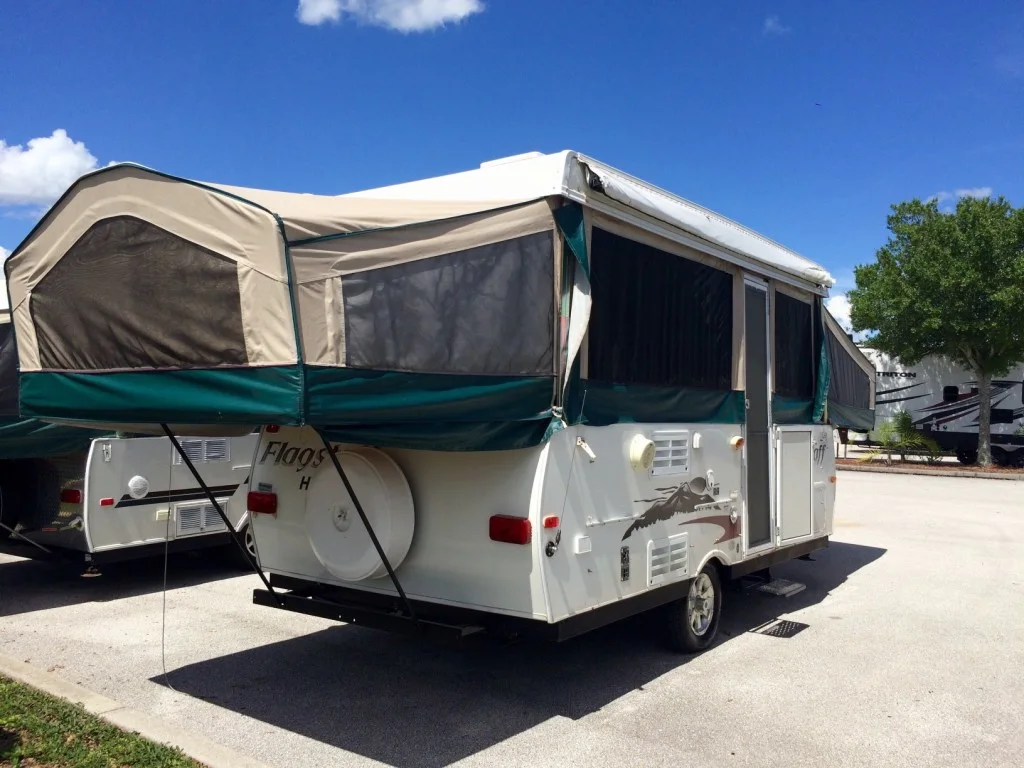Do Pop-Up Campers Hold Value?
Pop-up campers have been around for years. They’re efficient and lightweight options to take into the great outdoors.
From classic soft-sided pop-ups to modern hard-tops with extra features, these tiny campers are increasingly “popping up” all over the country.
We took a look at the benefits of different types of pop-up campers. And, we’ll reveal whether they hold their value as they age.
Let’s jump in!
What Is a Pop-Up Camper?
A pop-up camper is a towable RV. The sides can fold in and collapse with a crank under the hard-top roof for easier towing and storage. Some call them tent campers for this reason.
Pop-Up Camper Types
While most pop-up campers have soft sides, there are also hard-sided models. Let’s explore both versions.
Soft-Sided (Canvas)
Soft-sided pop-up campers’ sides are made of canvas, vinyl, or a similar material. The roof and base are typically aluminum or fiberglass. While they’re lighter than a hard-sided pop-up, they’re prone to leaks, tears, and mold. You can repair these issues, however.
Hard-Sided
Hard-sided pop-up campers have plastic or metal sides. The sides that pop out are called dormers. There are also a-frame pop-ups that fold up into a triangle roofline.
You use a motor or manual crank to put up hard-sided pop-ups. They’re easier to set up than soft-sided pop-ups, as there are no zippers or managing the fabric’s shape. But they’re heavier to tow.
Pro Tip: Unsure what pop-up camper is right for you? Check out these 5 Best Small Pop Up Campers.

Benefits of a Pop-Up Camper
Two of the main benefits of a pop-up camper are its towability and its short profile when folded. You can tow some of the lightest pop-ups with a car or small SUV. The ability to pull it with a broad range of vehicles eliminates the need to upgrade to a truck for towing if you don’t already have one. Its short profile, when collapsed, lets you store it in a garage or small barn.
Other benefits include low maintenance and the price. Pop-up campers have limited features and amenities, so their need for maintenance is minimal. At most, you’ll need to service the tires, canvas, or vinyl if it rips or leaks and keep up the beds and furniture inside.
Since these small campers are a step up from tent camping, they’re considered entry-level and affordable. If you have a small budget but want to RV, a pop-up camper can be a great starting point.
How Long Do Pop-Up Campers Last?
As long as you maintain a pop-up camper and keep it clean between uses, it can last up to 15 years or more. It’s important to make sure this type of camper is dry and clean before folding it up for storage.
The chances of it having mold or other issues lessen if you store it properly. If you have the space to store the camper inside or under a roof, there’s a greater chance of prolonging its life.

How Much Do Pop-Up Campers Cost?
Pop-up campers are budget-friendly. You can find new basic models under $10,000. And pop-ups with more features will run between $10,000 and $20,000 or higher. Hard-sided models tend to cost more than soft-sided ones.
Forest River’s Rockwood Tent 1640LTD is an example of a less expensive soft-sided option. The MSRP is about $8,000. In comparison, the Aliner LXE hard-sided A-frame camper has an MSRP of about $31,000.
Factors Affecting Pop-Up Camper Prices
Features and amenities are the main factors that ramp up the prices of pop-ups. For example, the Aliner LXE has hard sides, an extra dormer for the headroom, and a wet bath.
The shower and toilet alone are huge selling points and reasons for the higher price. It’s also lightweight with a 3,000-pound GVWR. You can tow it with some cars.
Construction is also a factor that affects prices. Pop-ups that are more customized, such as the Aliners, tend to sell for more than ones that large manufacturers like Forest River mass-produce. In addition, with material costs being at an all-time high right now, the MSRPs may fluctuate.

Do Pop-Up Campers Hold Value?
A brand new pop-up camper will depreciate at least 20% the minute you drive it off the dealer’s lot. This is true for any RV. But does it hold its value after that?
Unfortunately, a pop-up camper will likely depreciate about 38% the first three years, 75% over five years, and 88% over 10 years.
However, since the investment in a pop-up is relatively low, the depreciation isn’t as scary as with a larger, more expensive RV.
Pro Tip: Apart from their depreciating valuing, these are 5 Reasons To Avoid Pop-Up Campers.
Is Buying a Pop-Up Camper Worth It?
If you’re only going to camp periodically throughout the year, a pop-up camper can be a great investment. It gets you out of tent camping with a few creature comforts. We wouldn’t recommend a pop-up for long-term camping.
The downsides of pop-up campers include their thin walls, limited storage, and lack of amenities. But the upsides are their practicality, towability, and easy storage.
Weigh your options and budget when considering a pop-up. They’re fun and can get you out exploring. Have you ever camped in a pop-up?
Discover the Best Free Camping Across the USA
To be honest with you, we hate paying for camping. There are so many free campsites in America (with complete privacy).
You should give it a try!
As a matter of fact, these free campsites are yours. Every time you pay federal taxes, you’re contributing to these lands.
Become a FREE CAMPING INSIDER and join the 100,000 campers who love to score the best site!
We’ll send you the 50 Best Free Campsites in the USA (one per state). Access the list by submitting your email below: